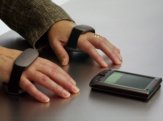Interacting with mobile products
By Alexander Piatidis, November 2002
The wireless society would seem to be approaching fast. The use of different types of wireless network and '3G' technology may soon be part of everyday life. However, as this wireless infrastructure takes shape then so too must new forms of interaction that allow people to use the new products and services that these networks will support. One hopes that these will be designed with real users and usage situations in mind.
Anyhow, significant development investments are currently being made worldwide - below are some of them, followed by some comments on their potential strengths and weaknesses from a user interaction perspective.
Voice and handwriting recognition - Microsoft's Tablet PC
Usable voice recognition interfaces have been 'just around the corner' for decades. They've never really quite made it as a general form of human-computer interaction, although have been extremely useful in certain special situations.
Microsoft have combined voice recognition with another natural form of human communication - handwriting recognition, again only utilised to a limited extent as a general purpose interaction technique. It remains to be seen how successful the Tablet PC will be in making these forms of interaction more universally usable - the intention is that it should be used in a wide variety of environments, being more portable than 'laptop' computers.
Nokia integrates full keyboards in mobile phones
With the increasing use of 'SMS' messages and the development of more sophisticated mobile email services, Nokia has seen the need to develop a more efficient way of entering text than the rather limited standard numeric keypad. This is in stark contrast with the direction of development in Microsoft's Tablet PC, though with the currently limited processing power of mobile telephones perhaps this is currently the only real option for such devices.
Virtual keyboards from Senseboard and Canesta
One of the most popular forms of data entry is still the standard full-size keyboard - the small mobile phone keyboards simply don't hack it for efficient and comfortable keying. However, the inherent lack of portability associated with a full-size keyboard is severely limiting.
Senseboard and Canesta are two companies that have developed virtual keyboards which address this problem directly. The Senseboard registers hand movements and thus deduces what the user is typing (assuming the user types 'correctly'), whereas the Canesta keyboard is a projection of a keyboard and detects where the user types on this projection.

|

|

|
| Microsoft Tablet PC | Nokia 6800 | Senseboard |
The user and the usage situation will be ever more important in the choice of technique for interaction with mobile products, and hence the design of the interfaces to these products...
- Voice and handwriting recognition may be more natural, however they're also relatively slow forms of communication, and in the case of voice recognition there are the obvious problems of noise and distruption to others, especially in many mobile usage situations.
- Miniturised keyboards may suit the young generation of mobile phone users, but are unlikely to suit the older businessman. Even if such keyboards can be used efficiently, recent press reviews have highlighted severe difficulties in configuring and using WAP-based email services.
- Virtual keyboards clearly have advantages in terms of being noiseless and portable, but lack the tactile feedback of normal keyboards and require greater attention to typing technique.
One thing is certain, and that is that those developing new interaction techniques must be user-centred in their approach. Indeed when one looks had the work going on in all the organisations named above then its clear that end-user involvement (both before and during development) has been a central focus.
Microsoft devoted thousands of hours into mobile user research before even reaching beginning concept development. Nokia work continuously with consumer research and usability testing. Both Canesta and Senseboard see usability work as critical to the success of their new virtual keyboards. We believe their efforts will increase the chances their products have for success.
Side note: We see Microsoft's decision to provide just one restart button - rather than the usual combination of three - as a useful development for users, though it would seem to indicate that a computer crashes are to remain a common event!!
Most hi-tech companies have, unsurprisingly, been very good at developing ideas for new technologies. However, technology must be developed hand-in-hand with users and a thorough understanding of the end usage situations. Unfortunately this is where all too many 'hi-tech' companies unwittingly run into trouble - placing all their effort into developing the new technology, rather than considering want users need from it and how it will be used.
Links:
- Microsoft Tablet PC - Microsoft's new portable computer with voice control
- Nokia 6800 - One of Nokia's new mobile telephones, with a 'full' keyboard
- Senseboard - The virtual keyboard from a Swedish company
- Canesta - An alternative virtual keyboard solution
Did you find this editorial interesting?
You might like to read some of our other editorials.
Please send us an email if you have any comments or suggestions!